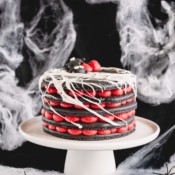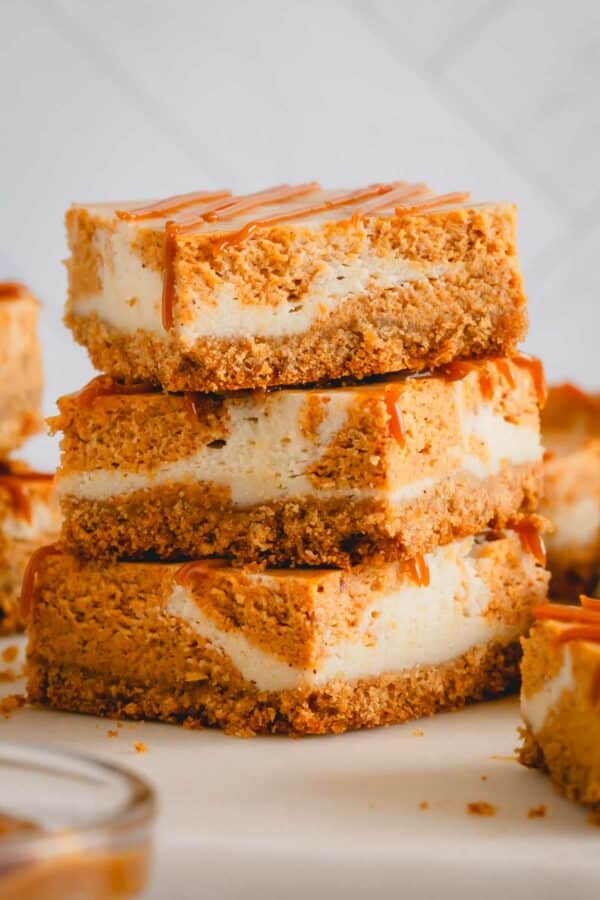This post is sponsored by Bob’s Red Mill. All opinions are mine.
Tall and impressive, this macaron cake is perfect for Halloween. Fluffy full macaron layers filled with sweet cream cheese frosting and wrapped in a sticky marshmallow spiderweb!
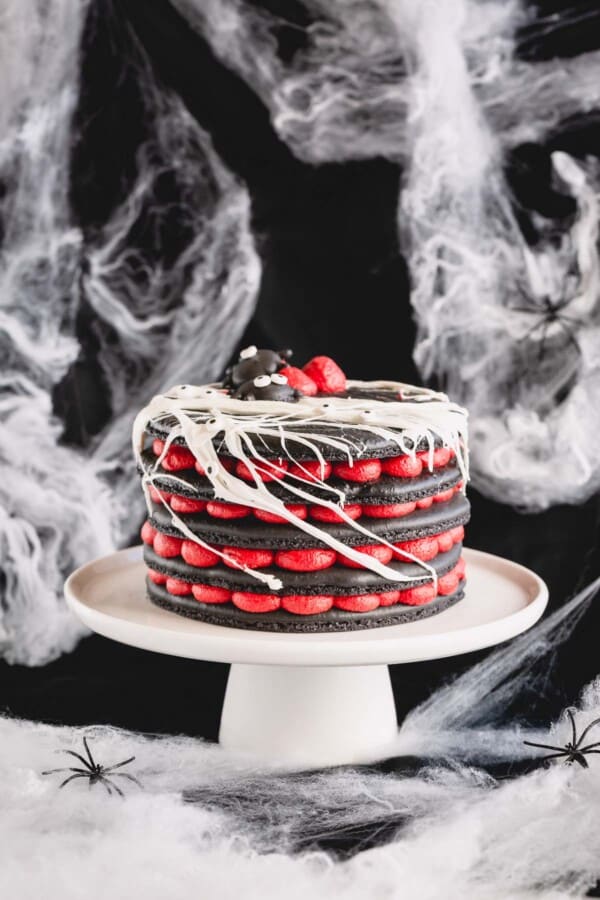
Table of Contents
Why you’ll love this cake:
How to get full macaron shells:
I’m so excited to partner with Bob’s Red Mill to highlight their super fine almond flour, my go-to almond flour for making macarons.
Thanks to its super fine texture, my macaron shells always come out nice and full and incredibly fluffy.
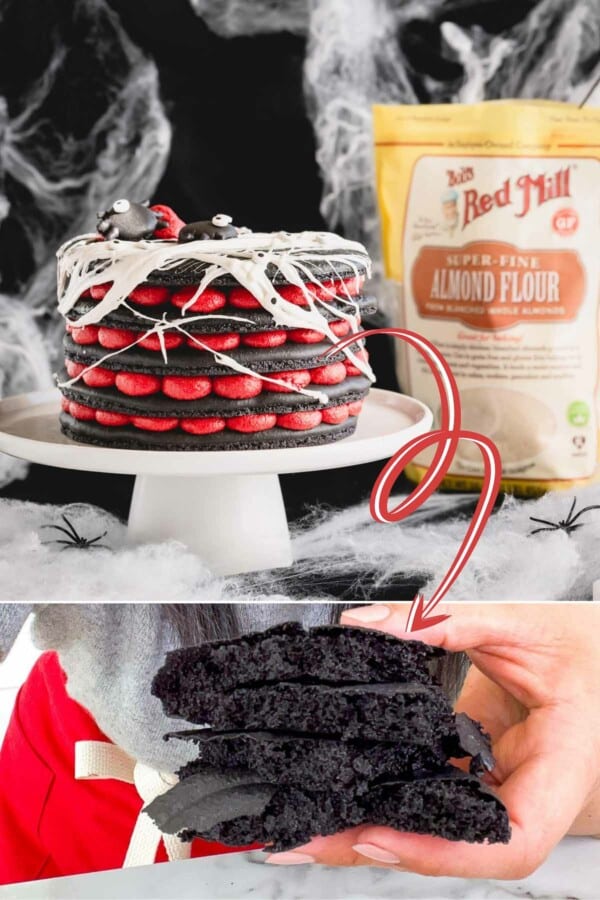
Why I love Bob’s Red Mill:
There’re many reasons I’m a huge fan of Bob’s Red Mill. This employee-owned company is committed to providing high-quality, minimally processed products from the mill to your table. Their products are available at any grocery store near you!
How to make macaron cake:
1. Make meringue
Stable meringue is key to perfect macarons.
Look for the following visual signs of the final meringue:
- Meringue balls up in the whisk.
- It has straight, pointy end.
- And it has sharp ridges/ribs all around.
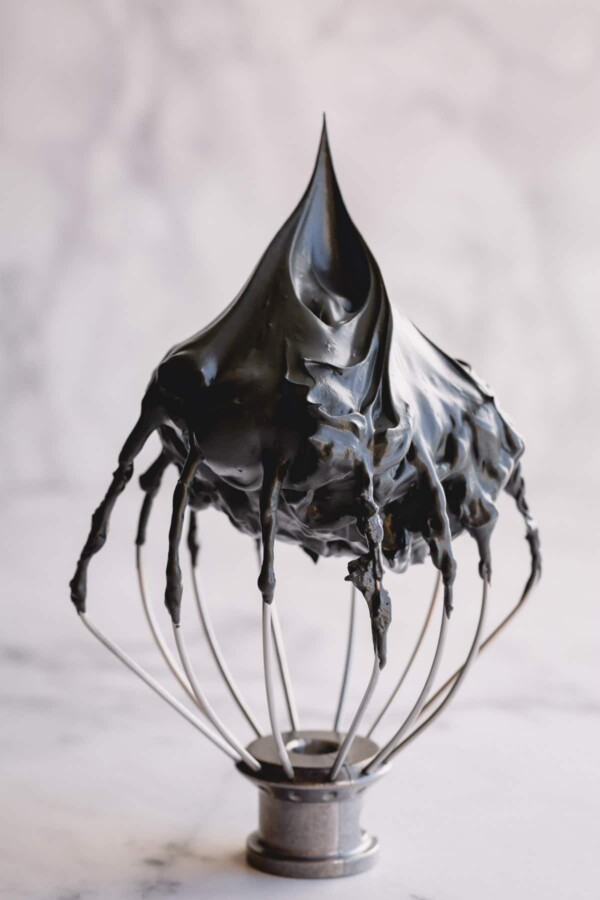
3 rules for the most stable French meringue:
- Make sure all the utensils for whipping meringue are clean and grease-free. It’s best to use glass or stainless steel bowl, as plastic bowls tend to hold onto grease. Any fat, including egg yolk, will prevent the egg whites to whip into a meringue.
- Whisk the meringue on a low and steady speed the entire time. It takes longer to reach stiff peaks, but it’s totally worth the time. It helps to great nice and full shells at the end!
- Add food coloring at soft peak stage to give it enough time to color the meringue evenly and prevent over-beating the meringue.
2. Sift dry ingredients
Sifting almond flour and powdered sugar is important for 2 reasons:
- To evenly combine flour and sugar
- To aerate the dry ingredients for utmost fluffy texture.
I recommend sifting dry ingredients 3 times. And always measure them before sifting.
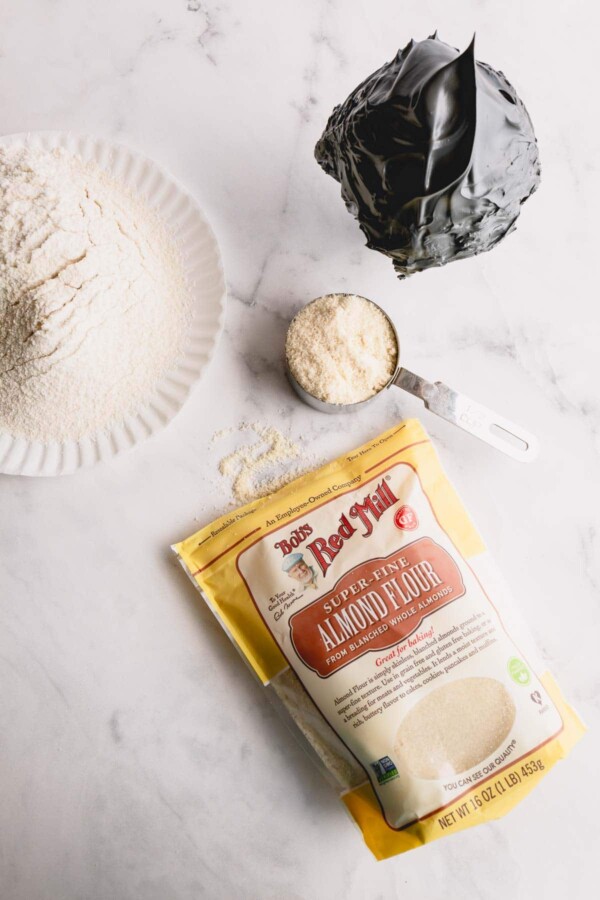
3. Macaronage
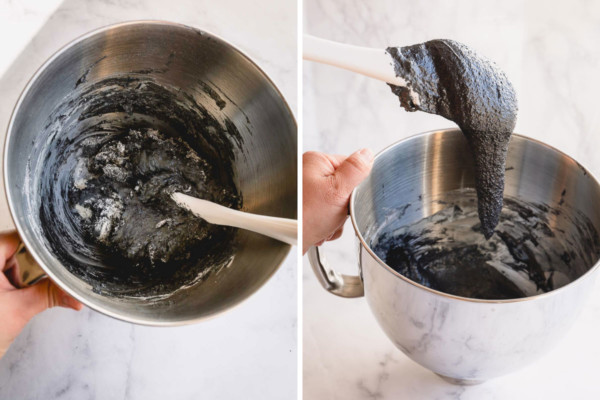
Add the dry ingredients into the meringue and fold the batter until it reaches lava like consistency.
My 10-second test: to test the batter, scoop up some batter with the spatula and slowly drop the batter back into the bowl. Now tilt the bowl to let the batter slowly flow. If the edges of the dropped batter melts back into the rest of the batter within about 8-10 seconds, your batter is ready.
4. Pipe and bake
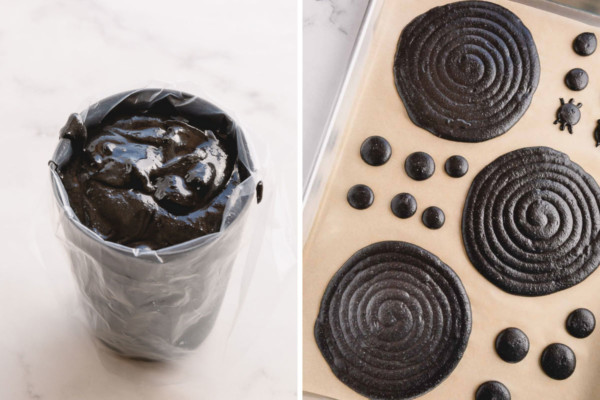
Transfer the batter into a piping bag with a round tip and pipe out six 5-inch rounds. You can also pipe a few small rounds for decorations and taste-testing.
Bake the shells at 300°F for 23-25 minutes. Before taking them out of the oven, gently and carefully push one of the shells. If it wobbles too much, baker for a minute or so more. The shells shouldn’t move.
FREE macaron cake template
5. Make cream cheese filling
We’re making basic cream cheese filling. The secret to the bright red color is adding a little bit of cocoa powder along with red gel food coloring.
Tip
You can add a little bit of brown food coloring instead of cocoa powder.
6. Assemble the cake
Make sure to cool the macaron shells completely before peeling them off the parchment paper, or silicone mat. They’re pretty fragile and break easily when warm.
Place the first layer on a serving platter, pipe the filling all over and place the next layer. Continue with the remaining layers.
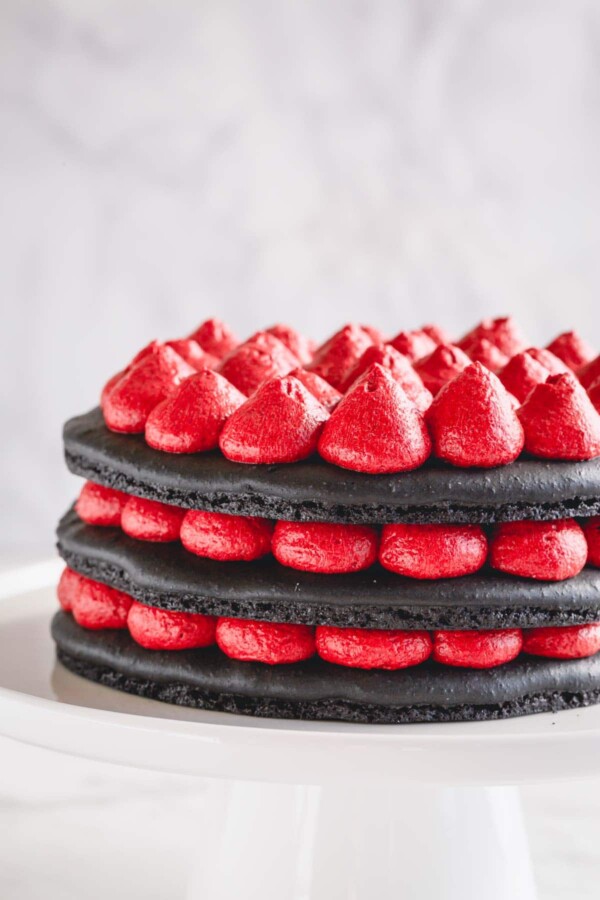
7. Make Marshmallow Spiderweb
The spiderweb decoration is the easiest part and so fun to make.
Simply microwave marshmallows for 15-30 seconds to melt it and let it cool slightly to touch.
Then take couple of spoonful of it and rub between your hands to create thin strands. Then apply it to your cake.
Tip
I like to use disposable vinyl gloves for this messy step for easy clean up.
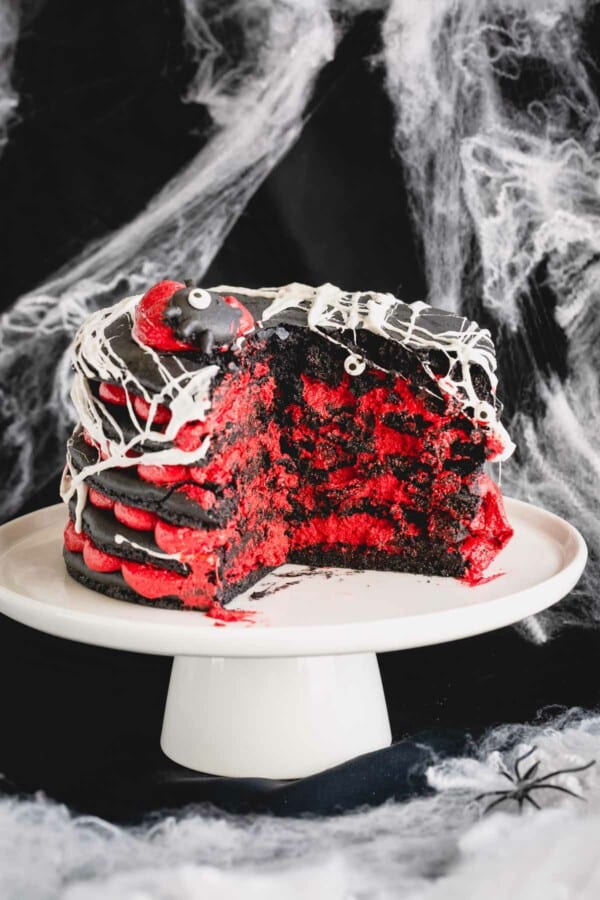
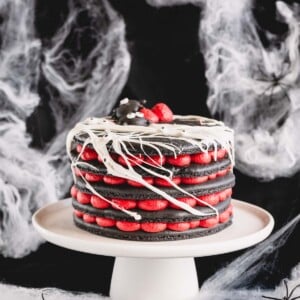
Halloween Macaron Cake
Ingredients
For macaron layers:
- 200 g Bob's Red Mill super fine almond flour Note 1
- 130 g powdered sugar Note 2
- 140 g egg whites at room temperature Note 3
- 150 g fine granulated sugar Note 4
- 2 teaspoon cream of tartar optional Note 5
- ¼ teaspoon coarse kosher salt
- 2 teaspoons black gel food coloring Note 6
For cream cheese filling:
- 110 g cream cheese softened
- 115 g unsalted butter softened
- 240 g powdered sugar
- 2 tablespoons unsweetened cocoa powder Note 7
- 1 teaspoon pure vanilla extract
- ¼ teaspoon coarse kosher salt
- 1 teaspoon red gel food coloring
For spiderweb decoration:
- 15 large marshmallows
- Candy eyes
Instructions
To make macaron layers:
- Preheat the oven to 300°F (150°C). Line 2 baking sheets with parchment paper, or teflon sheet, or silicone mat.
- To prepare dry ingredients, sift together almond flour and powdered sugar twice. (Note: If you have up to 2 tablespoons of chunky dry ingredients left in the sifter, you don't have to replace it. Simply discard those chunky bits.)
- To make meringue, in a clean mixing bowl with a whisk attachment, combine egg whites, granulated sugar, cream of tartar and salt and beat the mixture on medium speed until soft peaks form. (I set it to speed 4 on my KitchenAid stand mixer. It takes 30-40 minutes to whip the meringue, but it's well worth it for nice and full shells.)
- When the meringue reaches soft peaks, add black gel food coloring.
- Continue beating the egg whites on the same medium low speed until hard peaks form. Visual cues: Meringue should ball up inside the whisk, and when you lift the whisk, the meringue should hold a pointy end and have sharp ribs. (See pictures above or watch this meringue video for more information.)
- To make batter, sift almond flour mixture into the meringue. Using a silicone spatula, fold the dry ingredients into the meringue until fully incorporated. Then continue to fold the batter until it’s runny enough to draw a figure eight. To test, take a small amount of batter and drop it into the bowl. If the small peaks dissolve into the batter on its own in about 10 seconds, the batter is ready. If not, fold couple more times and test again. Be careful not to over-fold the batter. (TIP: Making french macarons is all about the technique. This is one of the most crucial step. Let me try to describe the folding motion as best as I can: run the spatula clockwise from the bottom, up around the sides and cut the batter in half. If you’re beginner macaron-baker, I suggest to count every fold. It takes roughly about 50 folds to reach the proper consistency. After 50 folds, start testing the batter, and continue testing after every couple folds.)
- To pipe macaron shells, transfer the batter into a pastry bag, fitted with a round tip. (I used this Wilton 2A tip.)
- Hold the pastry bag at straight 90° angle and pipe the batter from the center into a spiral until you've got about 5.5-inch circle. (TIP: Download my FREE macaron cake template.) You should get 6 circles. Pipe small macarons if you get leftover batter.
- Tap the baking sheets firmly on the counter (or using your hand) a few times to get rid of any air bubbles. You can also use a toothpick to burst some large air bubbles. This step ensures smooth tops.
- Let the macarons rest on the counter for 15 minutes before baking.
- To bake, working one baking sheet at a time, place one tray with macarons on the middle rack. Bake for 23-25 minutes. To test for doneness, touch a macaron lightly and try to move it. If it slides and wobbles, bake a minute or so longer. The cooked macarons should be firm to touch and the base shouldn’t move. (TIP: It’s always better to slightly over-bake macarons than under-bake them!)
- Cool macaron shells completely and then remove the shells from the parchment paper. (TIP: Don't remove the shells while warm, you may risk breaking the shells, or the bottom might get stuck to the baking surface.)
To make the filling:
- While macarons bake, prepare the cream cheese filling. In a mixing bowl with paddle attachment, beat the cream cheese and butter until fluffy.
- Add powdered sugar, cocoa powder, vanilla extract and salt and beat until well combined.
- Transfer the filling into a pastry bag fitted with a round piping tip. (I used Wilton 10 piping tip.)
To assemble the cake:
- Place one macaron layer on a serving platter.
- Pipe dollops of filling all over and then place the next layer over the filling. Continue with the remaining filling and macaron layers. (TIP: Don't be afraid to pipe the filling up to the edges of the macaron, so it shows better.)
- Place the filled macaron cake in the fridge.
To make spiderweb decoration:
- Place marshmallows in a microwave-safe dish and microwave for 15 seconds. Stir and microwave for another 15 seconds, if needed.
- Let it cool slightly until safe to touch.
- Take a few spoonful of marshmallow with your hands and stretch it between your hands to create thin strands. Wrap it around your cake. Repeat as needed.
- Pipe 3 dollops of frosting on top of the cake. And randomly place candy eyes over the marshmallow web.
- Let the assembled cake mature in the fridge for at least 8 hours, which allows the filling to soften and flavor the macaron layers.
- To serve, bring the macarons out about 30 minutes prior to serving.
